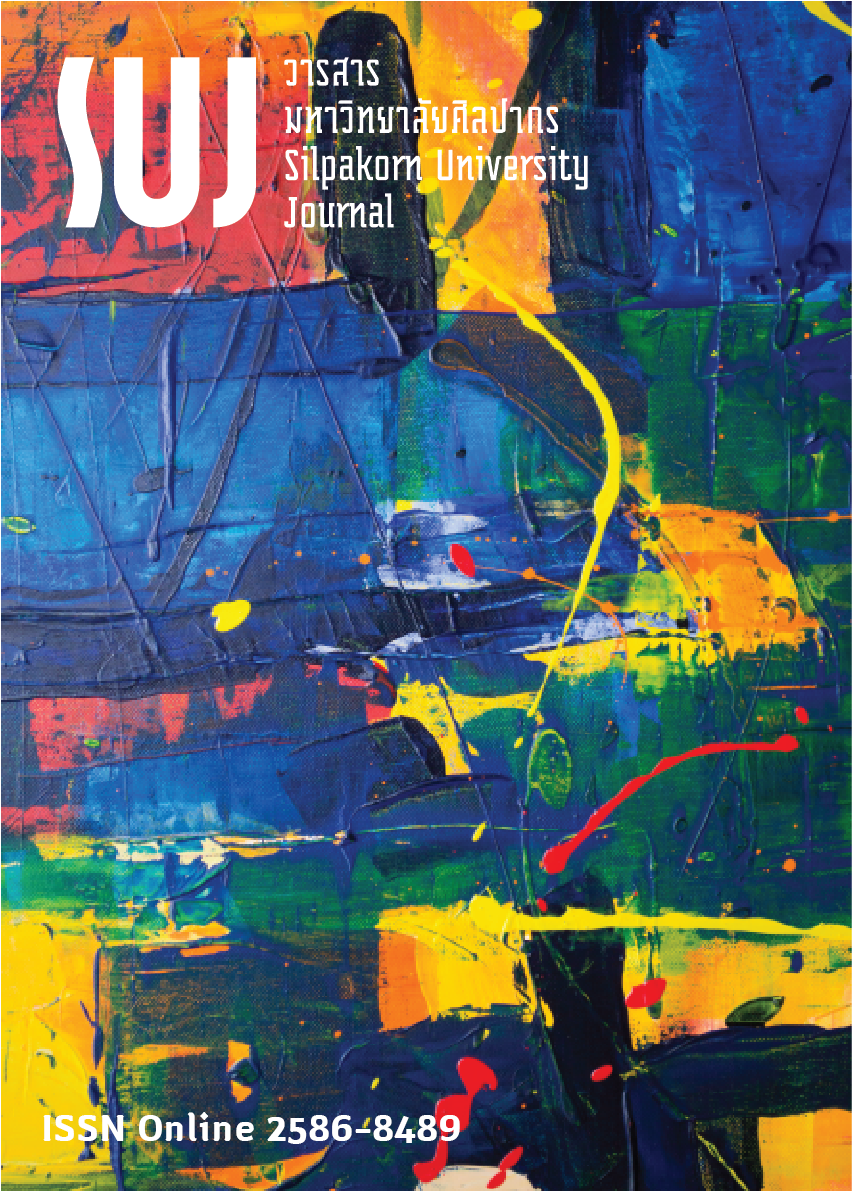ลำดับของรูปพยัญชนะในภาษาไทย (The order of consonant symbols in Thai)
Main Article Content
Abstract
อักษรไทยมีพยัญชนะ 44 ตัว โดยที่ 34 ตัวเป็นพยัญชนะที่วิวัฒนาการมาจากพยัญชนะในอักษรพราหมีผ่านทางอักษรคฤนถ์และอักษรขอมอีกทีหนึ่ง ส่วนอีกสิบตัวได้แก่ ฃ, ฅ, ซ, ฎ, ด, บ, ฝ, ฟ, อ และ ฮ ได้รับการประดิษฐ์ขึ้นโดยพ่อขุนรามคำแหงประดิษฐ์เพื่อเติมเต็มระบบเสียงภาษาไทยในขณะนั้น
พยัญชนะไทยในส่วนที่วิวัฒนาการมาจากอักษรพราหมีมีการเรียงลำดับเช่นเดียวกับในอักษรต้นฉบับ พยัญชนะ 33 ตัวแรกในอักษรพราหมี (ก ถึง ห) เป็นรูปแทนหน่วยเสียงและสามารถอธิบายลำดับได้ด้วย สัทลักษณ์ 5 สัทลักษณ์ คือ การสัมผัสกันของฐานกรณ์ในช่องปาก การผ่านโดยสะดวกของกระแสลม ฐานกรณ์ ความก้อง และกลุ่มลม พยัญชนะส่วนตัวสุดท้าย (ฬ) เป็นรูปแทนหน่วยเสียงย่อยที่ได้รับการนำมาวางไว้ต่อท้ายพยัญชนะที่แทนหน่วยเสียงอื่น พยัญชนะไทย 10 ตัวที่ประดิษฐ์ขึ้นใหม่ถูกนำมาแทรกระหว่างพยัญชนะเดิมอย่างค่อนข้างมีระบบ เมื่อวิเคราะห์ลำดับของพยัญชนะไทย 44 ตัวแล้วพบว่าสัทลักษณ์ที่ใช้ในการอธิบายลำดับของรูปพยัญชนะไทยมี 7 สัทลักษณ์โดยที่ 5 สัทลักษณ์แรกเป็นสัทลักษณ์เดียวกับที่ใช้ในการอธิบายลำดับของรูปพยัญชนะในอักษรพราหมี ส่วนอีก 2 สัทลักษณ์ที่ต้องใช้เพิ่มเติม คือการใช้เส้นเสียงและการเสียดแทรกของลม
การเรียงลำดับพยัญชนะในอักษรพราหมีเป็นไปอย่างมีระบบและไม่มีข้อยกเว้นใด แต่สำหรับพยัญชนะไทยพบว่ามีข้อยกเว้นบางประการในการเรียงลำดับ ข้อยกเว้นดังกล่าวเกิดขึ้นที่ลำดับของพยัญชนะ 5 ตัวคือ ฃ, ฅ, ซ, อ และ ฮ คือ 1) การนำพยัญชนะเสียดแทรก ฃ, ฅ, ซ ข้าไปปะปนกับพยัญชนะกัก 2) การนำพยัญชนะฐานกรณ์ปุ่มเหงือก ซ ไปปะปนกับพยัญชนะเพดานแข็ง และ 3) การที่ไม่นำ ฬ ซึ่งเป็นเพียงรูปพยัญชนะแทนหน่วยเสียงย่อยในภาษาดั้งเดิมของอินเดียไปไว้ท้ายสุดเหมือนในอักษรพราหมีอันทำให้ อ และ ฮ ดูเหมือนจะไม่ได้อยู่ในลำดับที่ควรจะเป็น
There are 44 consonant symbols in Thai script. Among them, 34 are derived from the Old Khmer script which is derived from Grantha, the south Indian Brahmi script. The other 10 consonants: ฃ, ฅ, ซ, ฎ, ด, บ, ฝ, ฟ, อ and ฮ were created by King Ramkhamhaeng to fit the Thai phonological system at that time.
The Thai consonants that are derived from Brahmi script are arranged systematically in the same order as in the original script. The first 33 consonant symbols in Bhrami (k to h) represent consonant phonemes and their order can be explained using 5 phonetic features: complete closure of articulators in the oral cavity, sonority, non-turbulent airflow in the vocal tract, place of articulators, voicing, and aspiration. The last consonant symbol (ฬ) represents just an allophone and, therefore, is placed after all other symbols. The 10 newly created Thai consonant symbols were quite systematically inserted among those derived consonants. After analyzing the order of the 44 Thai consonants, it was found that the order can be explained using 7 phonetic features in which 5 of them are the aforementioned ones used to explain the order of Bhrami script. The other 2 features are glottalization and friction.
The order of consonant symbols in Brahmi script is systematic without any exception but there are some exceptions to the order of Thai consonant symbols, namely ฃ, ฅ, ซ, อ and ฮ. The exceptions are (1) The fricative consonants ฃ, ฅ, and ซ are placed among stop ones, (2) The alveolar ซ is placed among palatal consonants, and 3) The traditional allophone symbol ฬ is not placed at the end of the list as in Brahmi script which makes the positions of อ and ฮ illogical in the alphabetical order, not in the way they are supposed to be.
Article Details
References
Danvivathana, Nantana. (1982). The Evaluation of Thai Script (วิวัฒนาการอักษรไทย). Bangkok: Thai Khadi Research Institute. Thammasat University.
Duroiselle, C. (1997). A Practical Grammar of the Pali Language.Tullera: Buddha Dharma Education Association.
Li, F. (1977). A Handbook of Comparative Tai. Hawaii: University Press of Hawaii.
Lo, L, K. (2012). Brahmi. [Online]. Retrieved October 2, 2014 from https://www.ancientscripts.com/brahmi.html
Omniglot. (n.d.). Brāhmī Alphabet. [Online]. Retrieved October 2, 2014 from https://omniglot.com/writing/brahmi.htm
Whitney, W. D. (2003). Sanskrit Grammar (Kindle version). [Online]. Retrieved October 2, 2014 from https://www.amazon.com
Jayaraj, A. (1991). A Descriptive Grammar of Nepali and an Analyzed Corpus. Washington: Georgetown University Press.

